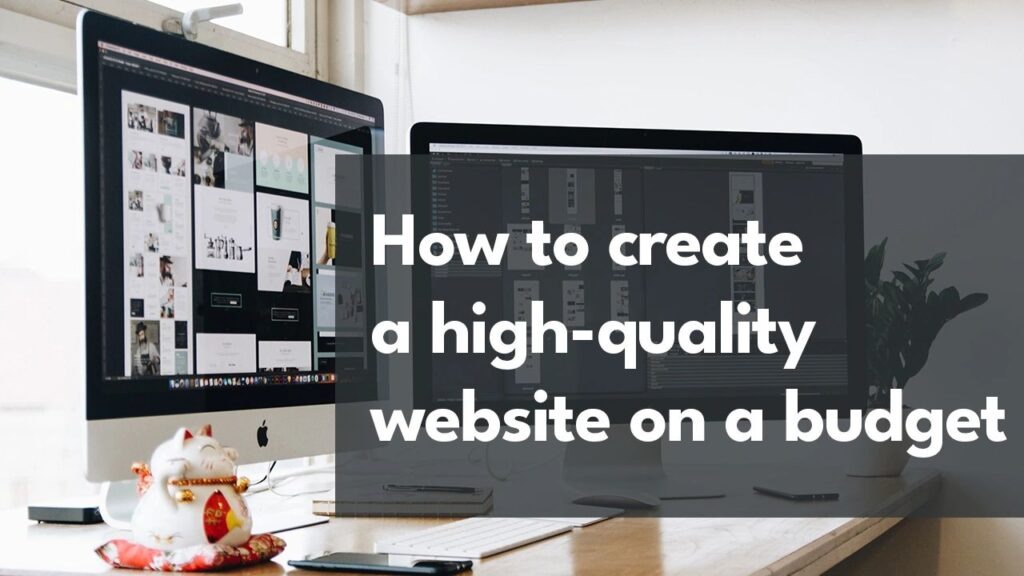Living in the digital world, a website is a no-brainer for any business; if you don’t have a website, you might as well not exist.
A sleek, well-designed website can be used to rock many different marketing strategies to help your business grow (news and blog content and info, oh my!). The web has a far more extensive reach than any other form of advertising, so make your website the center of your company’s online presence; you can advertise your business around the web on social networking sites, forums, and through pay-per-click advertising programs.
Having a website and online presence strategy allows you to market your business online. A website is also important because it helps to establish credibility as a business.
Now that we have established why a website is important, how can you go about building a high-quality, nicely branded website without spending all your hard-earned finances doing so?
Good news: a great website doesn’t have to cost a fortune. You can get a professional-looking design with a few pages – that’s enough to get started – with a small budget. Here’s how.
How to create a high-quality website on a budget :
1. Set Goals
First things first. What do you want your website to do? Will you be using your site only for advertising, or will it be used to sell your products? Knowing what to expect from the website can help you plan and manage it more efficiently.
Setting goals can also help you plan a potential website ROI (return on investment) and set a budget for the initial project and managing the website in the long term.
Think of goals like this: You’ll probably have a smaller budget for the website design and build if it is solely informational, such as a blog. But if your website helps sell a product or service, allowing users to sign up for an email list or information allows for greater potential return. This option may require clearing more room in your budget but could result in gaining more out of your investment.
Finally, if the website will be used for e-commerce, the potential return on investment from your website are any sales accrued. Look at that goal in connection to the budget to see what you think you can afford.
2. Pick a Foundation
DIY is one of the best ways to adhere to a budget long-term. If you plan to manage content over time, from blogging to adding items to an online store, pick a website foundation that you are comfortable with; you’ll be spending a lot of time working with it.
While WordPress is the most commonly used content management system available, you might already have experience with something else and that familiarity can be advantageous.
However, if you don’t have a preference–or you have little to no experience in the matter–do a little homework and look at different website builders and content management systems. Do you prefer something that’s visual with a drag and drop interface? Or do you know just enough that you can work in a more traditional CMS environment?
If you picked the website builder option, you can stick to a pretty tight budget by doing it yourself, using tools that come with these builders. (Common website builders include things like Squarespace and Wix.)
At this point, you need to make a decision: Will you build the website yourself or hire someone else? Sometimes, using a web design company, while more expensive, is worth the investment and will set your business up for success with a higher-quality website and built-in management services.
3. Use a Theme or Templates
No one likes a messy, badly-designed website, least of all potential clients. Regardless of the foundation you choose, there are themes, templates, and plugins to build features and functionality. Picking a solid theme can provide the basic design elements you want for the website.
When it comes to choosing a theme, look for something that appeals to your personal sense of style and includes features your business needs. Including too many features, especially ones you don’t need or won’t use, can be overkill. Make sure to pick a template or theme that’s responsive, so the design and website will work on all device types.
Themes, templates, and plugins are budget-friendly because of time savings. They can jumpstart a design with a ready-made framework and aesthetic that just has to be customized to meet your specific needs.
However, if you want to design a website that is on-brand for everything from colour palette to features, it might be worth hiring a marketing team to build your brand.
4. Have Website Content Ready to Go
If you like to cook, then you’ve heard of “mise en place”; getting all the ingredients prepped and ready to go so your cooking will be quick and efficient and nothing will be left out.
The same is true of your website. Do you already know what needs to be on your website? Is the content – text, blog posts, images, videos, links to email and social media accounts – packaged and ready?
Having all the content for the website ready in one location can save time (and money), speeding up the website building process. One of the first things a website designer will ask for is the content for your design.
If you’ve hired a team to create your content, it can be more costly and take time to build the website. Gather everything you want to include and have it ready when the project starts.
5. Cut Out Unnecessary Features
Trim the fat! More features and more pages often result in costly website design. Why do e-commerce features need to be built in if you aren’t planning to sell anything online? See the earlier point about setting goals.
Cut out unnecessary features. If you think you might want something later, have a conversation with the website designer about adding on features at a later time and if your website foundation has the potential for growth. (In most cases, the answer will be yes. This gives you the budget flexibility to grow the website project over time.)
6. Have a Go-To Person for Help
Once your website is off the ground, how do you plan to keep it in top working condition? You need a go-to person for help.
This might be the person that built your website with a monthly retainer or pay-as-you-go option. It might be a friend or colleague. It could be someone else you hire altogether.
No matter who you choose, it’s important to have a solid relationship with a qualified person who can help you through website issues in a pinch. If you have to cold call someone for help every time you hit a technical snag, costs can add up quickly.
Proper maintenance will save time, effort, and money in the long run.
Conclusion
A high-quality website is an invaluable investment in future growth. It’s your “storefront” to the world, a tool to build credibility and legitimacy, and the first impression someone might have of your brand.
Generally, creating a website is a good investment when you plan it for the scale of your organization or business.
Looking to outsource parts of your website and content marketing so you can get back to business? Megan Killion Consulting is a team of experienced, professional experts who can take over your marketing and branding so you can optimize your website and show your best side to the world. Contact us today so we can discuss your business needs and how we can help you build a high-quality website.

